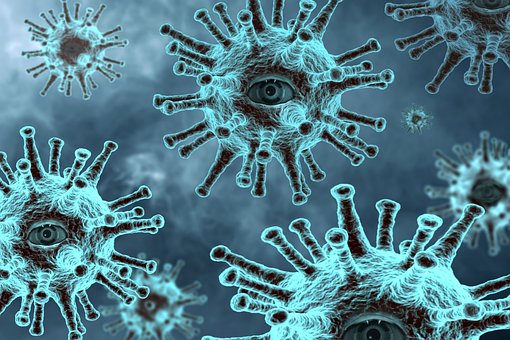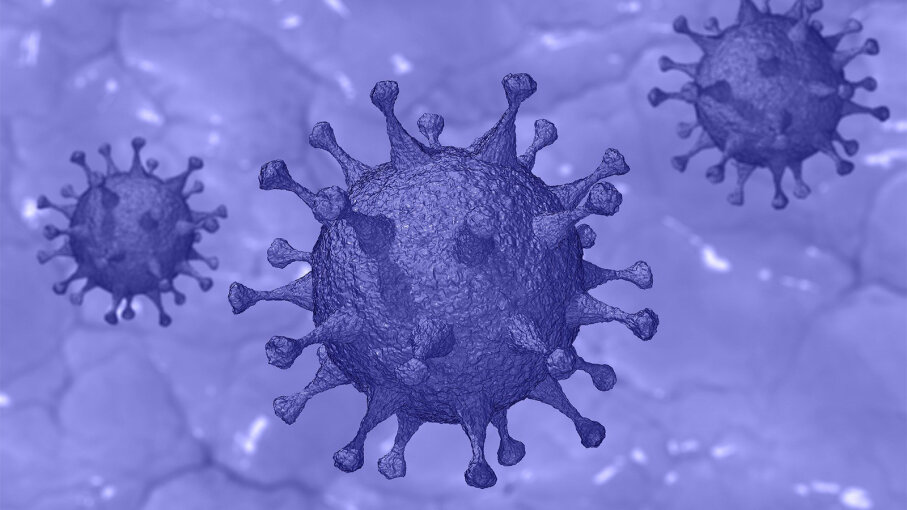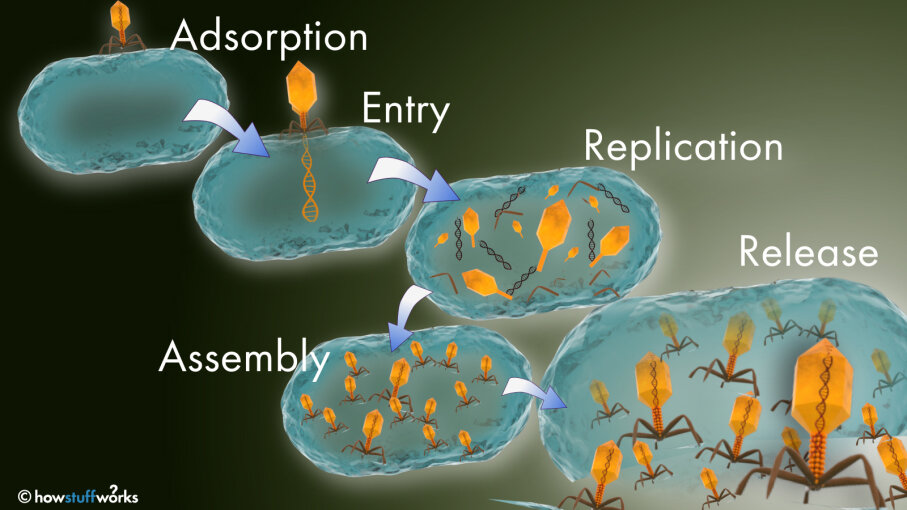

................................................................................................................................................................
Viruses
..
 Viruses vary
widely in their shape and complexity - viruses don't contain the chemical
machinery (enzymes) needed to carry out the chemical
reactions for life - so, a virus must have a host cell (bacteria,
plant or animal) in which to live and make more viruses - outside of a host
cell, viruses cannot function
Viruses vary
widely in their shape and complexity - viruses don't contain the chemical
machinery (enzymes) needed to carry out the chemical
reactions for life - so, a virus must have a host cell (bacteria,
plant or animal) in which to live and make more viruses - outside of a host
cell, viruses cannot function
BY CRAIG FREUDENRICH, PH.D. & PATRICK J. KIGER
 |
| An artist's rendering of the COVID-19 coronavirus molecule. |
Most of us at
one time or another have had colds or the flu, and we are especially vulnerable during
certain times of the year.
The symptoms —
fever, congestion, coughing, sore throat — spread through offices, schools and
homes, no matter where in the world we live.
Colds and flu
(influenza) are caused by viruses.
But viruses
are responsible for many other serious, often deadly, diseases including
COVID-19, AIDS, Ebola, hemorrhagic fever, infectious hepatitis
and herpes.
How can
viruses cause so much trouble? What makes us so vulnerable to them, and what
makes them spread?
In this
article, we will explore the world of viruses. We'll talk about what a virus
is, what viruses look like, how they infect us and how we can reduce the risk
of infection.
And you'll
learn why you feel so miserable when a cold virus attacks your body!
What Is a Virus?
If you have
read How Cells Work, you know how both bacteria
cells and the cells in your body work.
A cell is a
stand-alone living entity able to eat, grow and reproduce. Viruses are nothing
like that.
If you could
look at a virus, you would see that a virus is a tiny particle. Virus particles
are about one-millionth of an inch (17 to 1,000 nanometers) long [source: Milo
and Phillips].
Most viruses
are many times smaller than bacteria, though giant viruses — first
discovered in 2003 — are about the same size [source: Pennisi].
Bacteria, in
turn, are much smaller than most human cells.
Viruses are so
small that most cannot be seen with a light microscope, but must be observed with an
electron microscope.
A virus
particle, or virion, consists of the following:
Nucleic acid - set of genetic instructions, either DNA or RNA, either single-stranded or
double-stranded (see How Cells Work for details on DNA and
RNA)
Coat of protein - surrounds the DNA or RNA to
protect it
Lipid membrane - surrounds the protein coat
(found only in some viruses, including influenza; these types of viruses are
called enveloped viruses as opposed to naked viruses)
Viruses vary
widely in their shape and complexity. Some look like round popcorn balls, while
others have a complicated shape that looks like a spider or the Apollo lunar
lander.
Unlike human
cells or bacteria, viruses don't contain the chemical machinery (enzymes) needed to carry out the chemical
reactions for life.
Instead,
viruses carry only one or two enzymes that decode their genetic instructions.
So, a virus must have a host cell (bacteria, plant or animal) in which
to live and make more viruses.
Outside of a
host cell, viruses cannot function. For this reason, viruses tread the fine
line that separates living things from nonliving things.
Most
scientists agree that viruses are alive because of what happens
when they infect a host cell.
How a Virus
Infects You
 |
| In order to replicate, the virus depends on the host cell's chemical machinery. Note that these steps may differ slightly depending on the type of host cell that the virus is attacking. |
They can enter
us through the eyes, nose, mouth or breaks in the skin (see How the Immune
System Works for details).
Once inside,
they find a host cell to infect. For example, cold and flu viruses will attack
cells that line the respiratory or digestive tracts.
The human
immunodeficiency virus (HIV), which causes AIDS, attacks the T-cells of the
immune system.
Regardless of
the type of host cell, viruses follow the same basic steps to replicate:
1. A virus
particle attaches to a host cell.
2. The particle
releases its genetic instructions into the host cell.
3. The injected
genetic material recruits the host cell's enzymes.
4. The enzymes
make parts for more new virus particles.
5. The new
particles assemble the parts into new viruses.
6. The new
particles break free from the host cell.
All viruses
have some type of protein on the outside coat or envelope that
"feels" or "recognizes" the proper host cell(s). This
protein attaches the virus to the membrane of the host cell.
Some enveloped
viruses can dissolve right through the cell membrane of the host because both
the virus envelope and the cell membrane are made of lipids.
Those viruses
that do not enter the cell must inject their contents (genetic instructions,
enzymes) into the host cell.
Those viruses
that dissolve into a cell simply release their contents once inside the host.
In either case, the results are the same.
IMPORTANCE OF
HAND-WASHING
A study
published in 2020 by Massachusetts Institute of Technology researchers found
that improving the rates of hand-washing by travelers passing through airports
could significantly reduce the spread of viruses and other infectious diseases [source: MIT].
On the Inside
Once inside
the cell, the viral enzymes take over those enzymes of the host cell and begin
making copies of the viral genetic instructions and new viral proteins using the virus's genetic
instructions and the cell's enzyme machinery (see How Cells Work for details on the
machinery).
The new copies
of the viral genetic instructions are packaged inside the new protein coats to
make new viruses.
Once the new
viruses are made, they leave the host cell in one of two ways:
1.
They break the host cell open (lysis) and destroy the
host cell.
2.
They pinch out from the cell membrane and break away
(budding) with a piece of the cell membrane surrounding them. This is how
enveloped viruses leave the cell. In this way, the host cell is not destroyed.
Once free from
the host cell, the new viruses can attack other cells. Because one virus can
reproduce thousands of new viruses, viral infections can spread quickly throughout
the body.
The sequence
of events that occurs when you come down with the flu or a cold is a good
demonstration of how a virus works:
1.
An infected person sneezes near you.
2.
You inhale the virus particle, and it attaches to cells lining
the sinuses in your nose.
3.
The virus attacks the cells lining the sinuses and rapidly
reproduces new viruses.
4.
The host cells break, and new viruses spread into your bloodstream and also into your lungs. Because you have lost cells lining your
sinuses, fluid can flow into your nasal passages and give you a runny nose.
5.
Viruses in the fluid that drips down your throat attack the
cells lining your throat and give you a sore throat.
6.
Viruses in your bloodstream can attack muscle cells and cause you to have muscle
aches.
Your immune
system responds to the infection, and in the process of fighting, it produces
chemicals called pyrogens that cause your body temperature to
increase.
This fever actually
helps you to fight the infection by slowing down the rate of viral
reproduction, because most of your body's chemical reactions have an optimal
temperature of 98.6 degrees Fahrenheit (37 degrees Celsius).
If your
temperature rises slightly above this, the reactions slow down. This immune response continues until the
viruses are eliminated from your body.
However, if
you sneeze, you can spread thousands of new viruses into the environment to
await another host.
Lysogenic
Cycle
 |
| In the lysogenic cycle, the virus reproduces by first injecting its genetic material, indicated by the red line, into the host cell's genetic instructions. |
When the host
cell reproduces, the viral genetic instructions get copied into the host cell's
offspring.
The host cells
may undergo many rounds of reproduction, and then some environmental or
predetermined genetic signal will stir the "sleeping" viral
instructions.
The viral genetic
instructions will then take over the host's machinery and make new viruses as
described above. This cycle, called the lysogenic cycle, is shown in the
accompanying figure.
Because a
virus is merely a set of genetic instructions surrounded by a protein coat, and
because it does not carry out any biochemical reactions of its own, viruses can
live for years or longer outside a host cell.
Some viruses
can "sleep" inside the genetic instructions of the host cells for
years before reproducing.
For example, a
person infected with HIV can live without showing symptoms of AIDS for years,
but he or she can still spread the virus to others.
Reducing the
Spread
As we
discussed, viruses can exist for a long time outside the body. The way that
viruses spread is specific to the type of virus. They can be spread through the
following means:
· Carrier organisms - mosquitoes, fleas
· The air
· Direct transfer of body fluids from one
person to another — saliva, sweat, nasal mucus, blood, semen, vaginal secretions
· Surfaces on which body fluids have dried
To reduce the
risk of spreading or contacting viruses, here are things you can do:
· Cover your mouth or nose when you sneeze or cough by using a
tissue to cover your mouth or sneezing or coughing into your elbow.
· Wash your hands frequently, especially after going to the
bathroom or preparing food. If you're not able to wash your hands, apply hand
sanitizer liberally.
· Avoid contact with the bodily fluids of others.
· Consider wearing a face mask in public if you're worried about
infecting others or being infected yourself.
· Don't touch your face.
These
practices are not foolproof, but they can help you significantly reduce the
risk of viral infection.
Medicines That
Can Help
Contrary to
popular belief, antibiotics have no effect on a virus. Most antibiotics
interfere with the reproduction of bacteria, hindering their creation of new
genetic instructions or new cell walls.
Because
viruses do not carry out their own biochemical reactions, antibiotics do not
affect them.
Immunizations
work by pre-infecting the body so it knows how to produce the right antibodies
as soon as the virus starts reproducing.
Also, because
viruses reproduce so quickly and so often, they can often change slightly.
Sometimes, mistakes creep into their genetic instructions.
These changes
might alter the protein coat slightly, so one year's batch of vaccine might not
be as effective against the same type of virus next year.
This is why
new vaccines must be produced constantly to fight viral infections and prevent
outbreaks.
Not all
viruses are deadly. For example, people get colds all of the time and do not
die.
But influenza
kills tens of thousands of people in the U.S. each year, and other viruses,
such as Ebola virus, or West Nile virus and in early 2020, the COVID-19
coronavirus, have inflicted a heavy death toll worldwide.
And even these
commonplace viral infections can be deadly to a person who already has a
weakened immune system – people with AIDS, cancer patients taking chemotherapy,
elderly people or newborns.
We have to
take care not to spread viruses to these especially susceptible people.
After the
emergence of COVID-19 as a worldwide health threat in late 2019, public health
authorities emphasized a tactic called social distancing to help slow the
spread of the virus.
Basically, it
involves maintaining a physical distance of about six feet (1.8 meters) between
people and staying away from gatherings or crowded places.
The idea is to
prevent the spread of the virus through the spray of droplets when an infected
person coughs or sneezes.
In many parts
of the U.S., officials closed businesses, schools and other places where people
might come into contact with infected individuals and urged people to remain
indoors as much as possible.
While no one
expected that social distancing would eliminate new infections, the aim was to
slow the disease's spread — also known as flattening the curve – so that
hospitals would not be overwhelmed with large numbers of sick people [source: Wu].
VIRAL NOVELTY
Scientists are
continually discovering new viruses, including many that have no genes that
match ones researchers have come across before [source: Penn
Patrick Kiger
Patrick J. Kiger has written for
HowStuffWorks since 2008 covering a wide array of topics, from history and
politics to pop culture and technology. He worked as a newspaper reporter for
the Pittsburgh Press, and the Orange County Register in California, where he
covered one of the biggest serial murder cases in U.S. history, and also as a
staff writer at Baltimore Magazine. As a freelancer, Patrick has written for
print publications such as GQ, Mother Jones and the Los Angeles Times, and on
the web for National Geographic Channel, Discovery News, Science Channel and
Fast Company, among others. In recent years, he's become increasingly
interested in how technological advances are altering urban life and the design
of cities, and has written extensively on that subject for Urban Land magazine.
In his spare time, Patrick is a longtime martial arts student and a fan of
crime fiction, punk rock and classic Hollywood films.



No comments:
Post a Comment